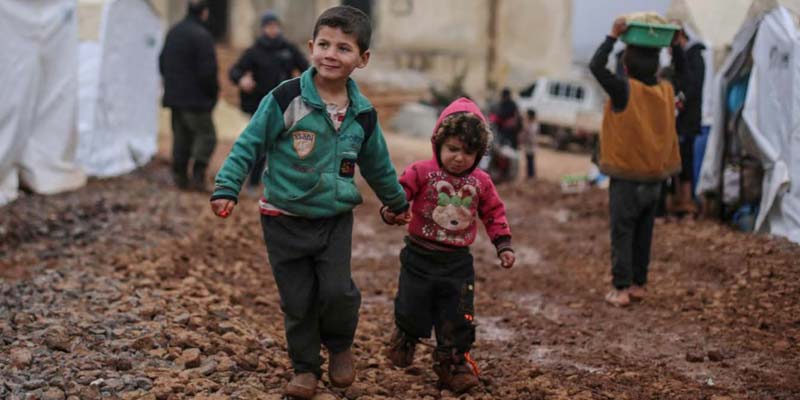- World
- May 06
19 million children displaced in 2019
An estimated 19 million children, more than ever before, were living in displacement within their own countries due to conflict and violence in 2019 – some of them for years, UNICEF said in a new report.
The report, ‘Lost at Home’, looks at the risks and challenges internally displaced children face, and the urgent actions needed to protect them. As COVID-19 continues to spread around the world, these children are among the most vulnerable to its direct and indirect impacts.
“Millions of displaced children around the world are already going without proper care and protection. When new crises emerge, like the COVID-19 pandemic, these children are especially vulnerable. It is essential that governments and humanitarian partners work together to keep them safe, healthy, learning and protected,” said UNICEF executive director Henrietta Fore.
Internally displaced children lack access to basic services and are at risk of exposure to violence, exploitation, abuse and trafficking, the report says. They are also at risk of child labour, child marriage and family separation which all pose direct threats to their health and safety.
The COVID-19 pandemic is making a critical situation for displaced children and families even worse. They often live in overcrowded camps or informal settlements, where access to basic hygiene and health services is limited, and where physical distancing is not possible. These conditions are highly conducive to the spread of diseases.
According to the report, there were 12 million new displacements of children in 2019, 3.8 million of them were caused by conflict and violence, and 8.2 million by disasters linked mostly to weather-related events like flooding and storms.
Through the report, UNICEF calls for strategic investments and a united effort from governments, civil society, private sector, humanitarian actors and children themselves to address the child-specific drivers of displacement, especially all forms of violence, exploitation and abuse.
UNICEF also calls on governments convening under the High-Level Panel on Internal Displacement, established by United Nations Secretary-General António Guterres, to take concrete action and investment that will help provide protection and equitable access to services for all internally displaced children and their families.
Critical to delivering on this agenda is better, timely and accessible data and evidence, disaggregated by age and gender, to improve collective understanding of how internal displacement affects children and their families. Internally displaced children and youth themselves must have a seat at the table, be taken seriously and offered the opportunity to be part of the solution, the report said.
Highlights of the report
Around 45.7 million persons were living in forced displacement as a consequence of conflict and violence at the end of 2019. The number has been over 40 million for the last five years – a steep increase from a decade ago, when around 25 million displaced persons were recorded. And millions more are displaced every year by natural disasters. Among the displaced population in 2019 were 19 million children – a share of almost 42 per cent – up from 11 million in 2009.
The largest number of internally displaced children due to conflict and violence can be found in West and Central Africa and in the Middle East and North Africa. Almost all of them live in just three countries — the Syrian Arab Republic (6.5 million), Yemen (3.6 million) and Iraq (1.6 million). Around five million of the displaced persons in this region are children.
Annually, the number of internally displaced persons regularly outpaces that of refugees, in many recent years at more than twice the total. And while most of those internally displaced do not end up crossing international borders, many will become refugees and vulnerable migrants. Internally displaced persons really are the invisible majority of the world’s displaced population.
The World Bank estimates there could be more than 140 million people internally displaced by climate by 2050. That’s 100 times the scale of Europe’s refugee and migrant crisis in 2015–2016.
In many countries around the world, internally displaced children persistently lack access to basic services. This effectively limits or denies them the right to education, health, protection and non-discrimination. These deprivations can be particularly acute in the life of a child. Removed from a stable, secure home and the communities they need to thrive – family, friends, classmates and teachers – internally displaced children are exposed to a host of harms and dangers. Family separation, negative coping strategies such as child labour and child marriage, and violence, exploitation, abuse and trafficking pose direct threats to their lives and futures.
Despite its global scale, internal displacement is largely overshadowed by the current political and public focus on refugees and migrants. Two United Nations (UN) agreements — the Global Compact for Migration and the Global Compact on Refugees — set objectives aligned with the commitment to leave no one behind captured in the 2030 Agenda for Sustainable Development. Yet despite the fact that the first step for many refugees and migrants in displacement is within their own borders, neither compact explicitly addresses the concerns of internally displaced people.
Protecting and including internally displaced children is not only right in principle – it also builds better societies and economies. When put into practice, these measures have the potential to generate huge returns for countries, driving economic growth and laying the path for more inclusive societies that ensure every child, no matter the circumstance, enjoys a childhood free from unnecessary harm.
As the High-Level Panel on Internal Displacement convenes in 2020 to address the global challenge of internal displacement, UNICEF calls on countries to ensure principles – and practices – place children front and centre. These measures must provide safe homes, protection and equitable access to services for every internally displaced child and translate into tangible impact in the lives of children on the ground.
Manorama Yearbook app is now available on Google Play Store and iOS App Store

